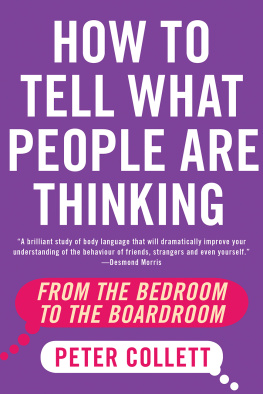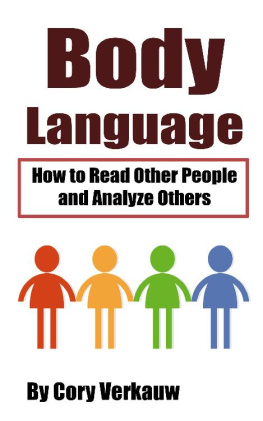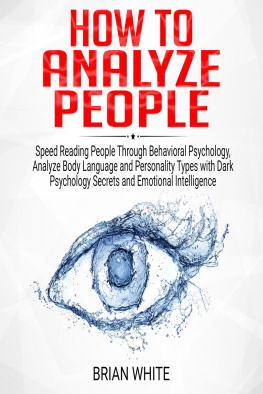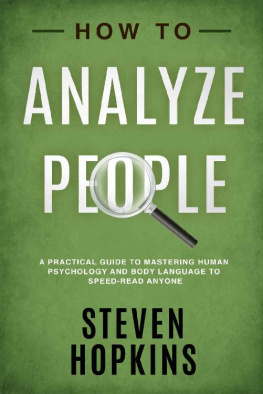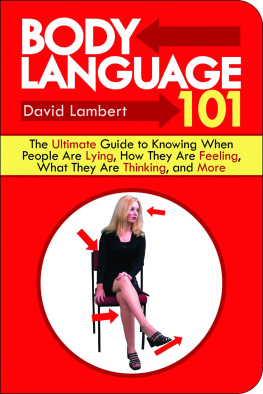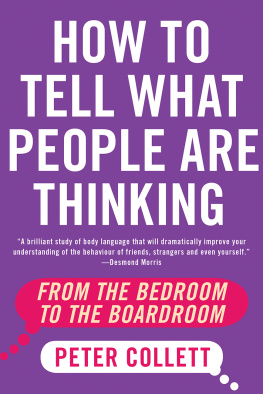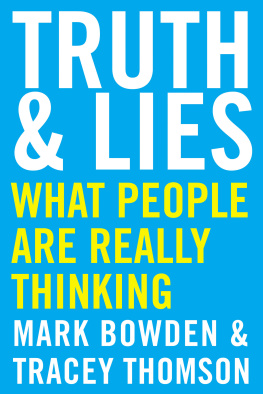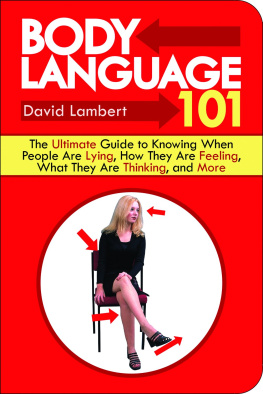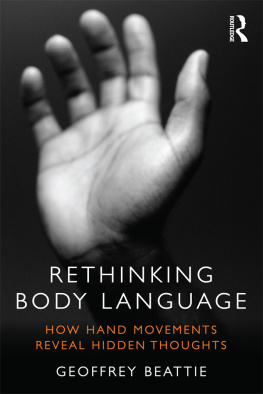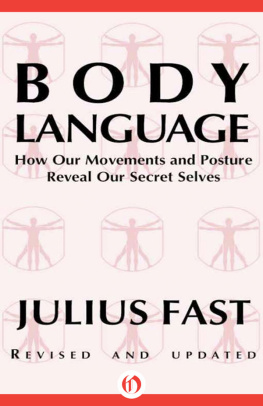Peter Collett - How to Tell What People Are Thinking
Here you can read online Peter Collett - How to Tell What People Are Thinking full text of the book (entire story) in english for free. Download pdf and epub, get meaning, cover and reviews about this ebook. year: 2016, publisher: HarperCollins Canada, genre: Religion. Description of the work, (preface) as well as reviews are available. Best literature library LitArk.com created for fans of good reading and offers a wide selection of genres:
Romance novel
Science fiction
Adventure
Detective
Science
History
Home and family
Prose
Art
Politics
Computer
Non-fiction
Religion
Business
Children
Humor
Choose a favorite category and find really read worthwhile books. Enjoy immersion in the world of imagination, feel the emotions of the characters or learn something new for yourself, make an fascinating discovery.
- Book:How to Tell What People Are Thinking
- Author:
- Publisher:HarperCollins Canada
- Genre:
- Year:2016
- Rating:3 / 5
- Favourites:Add to favourites
- Your mark:
- 60
- 1
- 2
- 3
- 4
- 5
How to Tell What People Are Thinking: summary, description and annotation
We offer to read an annotation, description, summary or preface (depends on what the author of the book "How to Tell What People Are Thinking" wrote himself). If you haven't found the necessary information about the book — write in the comments, we will try to find it.
Have you ever wondered what people are thinking or if they are telling the truth? Did you know that you can discern someones thoughts by reading the clues in a persons body language? Did you know that the position of your hand during a handshake shows whether you have a submissive or a dominant personality? And that your apparently unconscious choice to say do not instead of dont can indicate that you are lying? These revealing clues (and many more) provide insights into peoples innermost thoughts. In this entertaining and illuminating guide, Peter Collett decodes the fascinating intricacies of body language and speech.
How to Tell What People Are Thinking — read online for free the complete book (whole text) full work
Below is the text of the book, divided by pages. System saving the place of the last page read, allows you to conveniently read the book "How to Tell What People Are Thinking" online for free, without having to search again every time where you left off. Put a bookmark, and you can go to the page where you finished reading at any time.
Font size:
Interval:
Bookmark:
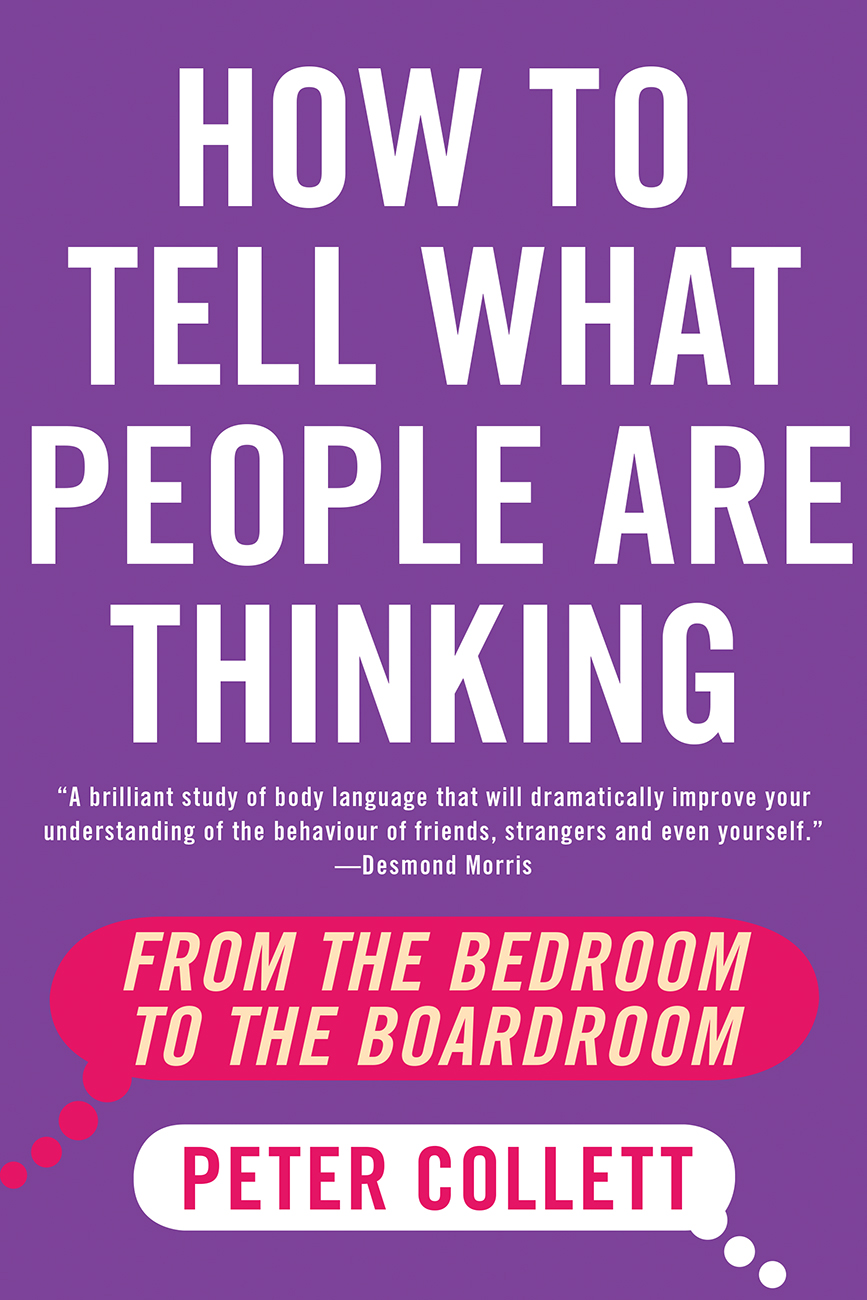
For Jill, Katie and Clementine
Contents
I would like to thank my wife, Jill, and my daughters, Katie and Clementine, for their patience and loving support, without which this book would not have been possible. Thanks are also due to my agent, Caradoc King, for his advice and encouragement, to Martha Lishawa and Linda Shaughnessy at A. P. Watt, to Brenda Kimber, Marianne Velmans and Sheila Lee at Doubleday, and to Beth Humphries, for all the help and support they have given me. In addition I would like to express my gratitude to my brother, Tony, and his wife, Julia, for their encouragement over the years, as well as to the following friends and colleagues for their valuable help and suggestions: Suzie Addinell, Max Atkinson, Rad Babic, Geoffrey Beattie, Steven Beebe, Giovanni Carnibella, Alberta Contarello, Tina Cook, Paul Ekman, Norma Feshbach, Seymour Feshbach, Mark Frank, Adrian Furnham, Tim Gardam, Doris Ginsburg, Gerry Ginsburg, Fergus Gleeson, Peter Henderson, Tim Horner, Brett Kahr, Christine Kuehn, Mansur Lalljee, Roger Lamb, Peter Marsh, Marie OShaughnessy, Sophie Ratcliffe, Monica Rector, Rachel Reeves, Bryan Richards, Dunja Sagov, Sandra Scott, Barry Shrier, Caroline Simmonds, Frank Simmonds, Mary Sissons Joshi, Charles Smith, Michael John Spencer, Oliver Spiecker, Martine Stewart, Michael Stewart, Paddy Summerfield, Gaby Twivy, Paul Twivy and Peter van Breda. Finally I would like to record my special thanks to Peter du Preez, Michael Argyle and Desmond Morris, who taught me so much of what I know and encouraged my interest in human behaviour.
Lets imagine that youre talking to an old friend about people you dated in the past. You casually ask him if he regrets breaking off with the attractive girl he was dating during his final year at school. Oh no, he replies, I dont have any regrets, and it didnt upset me when we broke up either. As hes talking, your friend briefly wipes the skin under his right eye with his index finger. Theres no reason why you should notice this tiny gesture, and if you did youd probably think that he was just removing a bit of dust from his face. But he isnt. The gesture is in fact a tell, and it casts an entirely different light on your friends true feelings. Although he says that the bust-up didnt disturb him, part of his brain knows otherwise, and it instructs his finger to wipe away an imaginary tear. So, while the conscious part of his brain is saying, I wasnt upset, another part is producing a tell which says, Well actually, I was upset! Momentarily your friend might recognize his complicated feelings, but its highly unlikely that he notices what his unruly finger is doing, or what it reveals about his true feelings.
The friend who wipes away an imaginary tear produces an autonomous tell in other words, a tell that has no purpose other than to reveal his true feelings. Because autonomous tells arent intentional, they are hardly ever noticed by the people who produce them or the people who witness them. Thats not necessarily the case with attached tells, which are connected to some other activity. For example, when two people are introduced to each other, the fact that they shake hands may be less informative than how they actually do so. How tightly they grip each others hand, how they position their palm, how much enthusiasm they show, how much control they try to exert, the actual words they use to greet each other these are attached tells. Within the greeting ritual they reveal what each person is really like, and what theyre trying to achieve with the other person.
Whether a tell is an action or the way that an action is performed usually depends on how common the action is. Consider two societies one where men regularly greet each other with a kiss on the cheek, and another where they hardly ever do so. When two men kiss each other in the first society they are simply doing what all the other men do. The fact that they kiss each other is therefore not very informative it doesnt tell us anything about their relationship. However, how they kiss each other does tell us about their relationship. The situation in the second society tends to be reversed. Here, when two men greet each other with a kiss on the cheek they are doing something unusual. Now its the kiss itself, rather than the way its performed, that tells us what kind of relationship the two men have.
Poker Tells
The word tell comes from the game of poker, where its used to refer to the signals that players unintentionally produce when theyre trying to conceal what kinds of cards theyre holding or the strategy theyre employing. There are two essential skills in poker one is the capacity to hide ones feelings, so that the other players have no idea whether youre holding a bad hand or a royal flush. This is the ability to keep a poker face to remain completely enigmatic. The other essential skill is the ability to read peoples behaviour to work out what kind of cards theyre holding, simply by observing their actions and listening to what they say. While you, as a poker player, are looking for tell-tale signs in another players behaviour, hes busy doing everything he can to mislead you. The reverse is also true while the other players are trying to figure out what youre up to, youre doing everything in your power to ensure that you dont give them anything to go on, or if you do that it sends them off in the wrong direction.
One of the ways that poker players can improve their game is by learning to recognize the links between their opponents actions, the cards that theyre holding and the moves they make. They can start to pay attention to little things, like the way someone holds his cards or the way he looks at them, the way he makes a call, what he does with his hands, how he fiddles with his glasses the list of potential tells is endless. Mike Caro has made a lifelong study of poker tells and the ways that players give themselves away by sighing, humming, tapping their fingers, playing for time, checking their cards and trying to lay false trails. Several films, like House of Games and Rounders, have included scenes where the plot turns on someone discovering a poker tell. In Rounders, for example, theres a showdown game of poker between Mike, the hero (played by Matt Damon), and Teddy KGB, a Russian mobster (played by John Malkovich) who likes to break open Oreo cookies and eat them while hes playing poker. Mike eventually wins the game by working out the Russians tell when he splits the cookie beside his ear hes got a good hand, but when he splits it in front of his face it means that hes bluffing!
Poker players have lots to think about. Apart from deciding what to do next, theyre constantly trying to undermine other players attempts to understand them, while doing everything possible to see past the defences erected by the other players. It all seems very confusing, but in fact its no more complicated than the things that we all do every time we relate to other people. In our daily encounters were constantly trying to project an image of ourselves, and so are other people, and while theyre trying to work out what we are thinking, were doing the same to them. Our chances of success, like those of the poker player, will always depend on how sensitive we are to other people, and whether we can recognize and understand their tells.
Defining Tells
Everyday tells are highly informative. The way you stand when youre talking to someone how you move your feet, hands, eyes and eyebrows says a lot about your commitment to the conversation and your underlying attitude to the other person. It also affects how long you get to talk and how often you get interrupted. How you position your arms and legs when youre seated also provides a wealth of information about your mood and intentions, showing whether you feel dominant or submissive, preoccupied or bored, involved or detached. The way you smile the facial muscles you use and how rapidly you enlist them shows whether youre genuinely happy, faking it, lying or telling the truth, feeling anxious, miserable, superior or unsure of yourself. Speech disfluencies are also highly informative. The way you hesitate when youre speaking, how you um and er, provides important clues to your mood. While the words you choose, the phrases you select, and the way you construct your utterances may convey an official message to other people, your linguistic choices also contain disguised messages which reveal your true intentions.
Font size:
Interval:
Bookmark:
Similar books «How to Tell What People Are Thinking»
Look at similar books to How to Tell What People Are Thinking. We have selected literature similar in name and meaning in the hope of providing readers with more options to find new, interesting, not yet read works.
Discussion, reviews of the book How to Tell What People Are Thinking and just readers' own opinions. Leave your comments, write what you think about the work, its meaning or the main characters. Specify what exactly you liked and what you didn't like, and why you think so.

